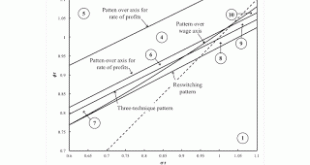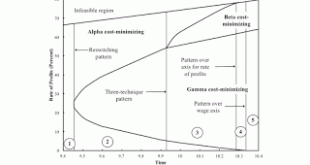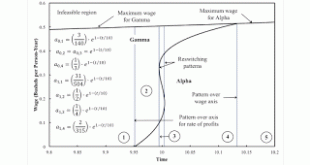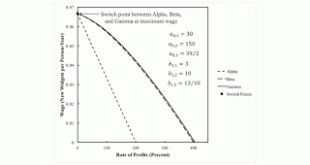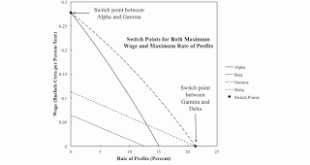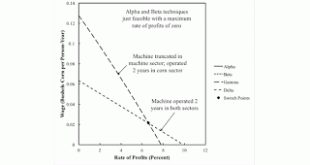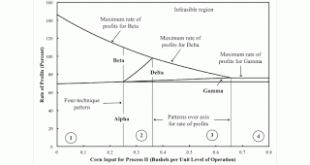Can I adapt Roemer's work, suitably taking into account later work by D'Agata and Zambelli, to found this approach to markup pricing? As a start, I here quote Roemer on a reproducible solution (RS), before he takes into account unequal rates of profits and a choice of technique. Given the role of endowments, is this a neoclassical approach, like Hahn's 1984 CJE paper? Even so, is it a valid justification for Sraffa's price equations? Notice there are no subscripts for time below. "There...
Read More »The Tractor-Corn Model: A Start
1.0 Introduction In my ROBE article, I consider fluke switch points arising from perturbations of coefficients of production in the Samuelson-Gargenani model, but in the case with only circulating capital. An obvious generalization is to consider fixed capital. This generalization is simplified by restricting oneself to the case in which machines operate with constant efficiency. Steedman (2020) analyzes this case, and this post is a start on working through elements of the corn-tractor...
Read More »The Truncation Of The Economic Lives Of Machines
'Paradoxes' and 'Perversities' PhenomenonExampleRegionReswitching'One good'5Schefold reswitching3Schefold roundabout3Baldone8Recurrence of technique (without reswitching)Baldone9Recurrence of truncation (without reswitching or recurrence of technique)Two sectors with fixed capital2Non-monotonic variation of economic life of machine (without reswitching or recurrence of technique or of truncation)Baldone10'Non-continuous' variation in economic life of machine associated with infinitesimal...
Read More »More On Baldone Example
Figure 1: A Two-Dimensional Pattern Diagram, Enlarged1.0 Introduction This post further generalizes an example from Salvatore Baldone.. Like an example from Bertram Schefold, I find that Baldone's example is in a wedge near the edge of the appropriate region in one of my partitions of a parameter space. I have some very complicated spreadsheets that allow me to quickly visualize the effects of varying parameters. Baldone and Schefold were working long before Visicalc, Microsoft Excel, or...
Read More »An Extension Of An Example From Salvatore Baldone
Figure 1: A Pattern Diagram, Enlarged1.0 Introduction This post looks at and generalizes an example of the recurrence of techniques by Salvatore Barone. It is an example with fixed capital illustrating the recurrence of the period of truncation. In the generalization, I find what I call patterns over the axis for the rate of profits, a patern over the wage axis, a three-technique pattern, and a reswitching pattern. Barone's example demonstrates that around a switch point, a lower rate of...
Read More »Triple Switching and Fluke Switch Points
Figure 1: A Pattern Diagram with Triple Switching In demonstrating the lack of foundation for claims of the Austrian school about the supposed relationships between a greater supply of capital, a consequent lower rate of profits, and a longer period of production, I have so far only presented examples in which the economic life of an existing machine can be extended or truncated. Schefold (1980: 170) interprets a more roundabout technique as one in which a long-lived machine is used to...
Read More »A Three-Technique Pattern Over The Wage Axis
Figure 1: Wage Frontier for a Fixed Capital Example This post presents a perturbation of parameters in a 'one good' model of fixed capital. The coefficients of production differ from those in this reswitching example. But the model has the same structure. Consider a one-commodity economy in which labor and widgets are used to produce new widgets, the only consumption good. (The use of the term 'widget' to designate the single produced commodity emphasizes how unrealistic this model is.)...
Read More »Fluke Switch Points At Both The Maximum Wage And The Maximum Rate Of Profits
Figure 1: Wage Frontier for a Fixed Capital Example1.0 Introduction I continue to explore the simplest multisector model of the production of commodities by means of commodities in which circulating and fixed capital is used in both sectors. In previous explorations, I locate a four-technique pattern, observe recurrence of truncation, and provide an example in which truncating all machines is infeasible. I think my taxonomy of fluke switch points and methods of visualizing the effects of...
Read More »Infeasibility Of All Machines Truncated
Figure 1: Factor Wage Curves For Feasible Techniques There are 12 coefficients that can be varied in my minimum multisector model in which production in all sectors can require both fixed and circulating capital. I do not think I am being very orderly in exploring this twelve-dimensional space. This is a fluke case in which the maximum rate of profits is zero for both the Alpha and the Beta techniques. If only new machines are used as means of production in producing new machines and in...
Read More »Recurrence Of Truncation In A Perturbation Analysis
Figure 1: Variation of Choice Of Technique with a Coefficient of Production This post continues the analysis of this example. The coefficients of production and the techniques are the same as in the linked post, except here I consider the results of varying a1, 2, the amount of corn needed as circulating capital in operating Process II at unit level. Figure 1 above shows how the choice of technique varies with this parameter. This is a two-sector model, in which new machines and corn are...
Read More » Heterodox
Heterodox

